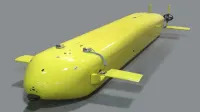Recharge Wrap-up: NASA’s EV plane, GM and Navy partner on fuel cell drone sub

Suzuki has made its Baleno hatchback more efficient with a mild hybrid system. The European model has a lithium-ion battery pack under the front passenger seat that stores energy from a regenerative braking system to supplement power from the 1.2-liter engine during acceleration. Suzuki says the system improves the Baleno’s fuel economy and reduces CO2 emissions by about five percent. Read more from Automotive News Europe.
The Borgward BX7 plug-in hybrid SUV has won several Plus X Awards. The revived German automaker’s PHEV received awards in the categories of Design, High Quality, Ergonomics, and Functionality. Any Plus X Award winner must display added value, which the panel of judges call the “Plus X Factor.” The BX7 launched in China earlier this year, with plans to go on sale in India later this year and Europe soon after that. Read more at Green Car Congress.
General Motors and the US Navy are teaming up to power underwater drones with hydrogen fuel cells. The Navy’s goal is to provide its large displacement unmanned undersea vehicles (UUVs) with 60 days of operation between refueling. “Our in-water experiments with an integrated prototype show that fuel cells can be game changers for autonomous underwater systems,” says Frank Herr, head of Ocean Battlespace Sensing at the Office of Naval Research. “Reliability, high energy, and cost effectiveness – all brought to us via GM’s partnering – are particularly important as Navy looks to use UUVs as force multipliers.” GM says that just as on-road experience gained through its Project Driveway fuel cell test fleet is valuable, automotive customers stand to benefit from lessons learned from this naval project. Read more in the press release below.
Hydrogen fuel cell technology could augment ships and subs on patrol
WASHINGTON, D.C. – General Motors, the Office of Naval Research and the U.S. Naval Research Laboratory are cooperating to incorporate automotive hydrogen fuel cell systems into the next generation of Navy unmanned undersea vehicles, or UUVs.
Hydrogen fuel cells convert high-energy hydrogen efficiently into electricity, resulting in vehicles with greater range and endurance than those powered with batteries. Under the ONR’s Innovative Naval Prototype program for Large Displacement UUVs, energy is a core technology in the Navy’s goals for vehicles with more than 60 days endurance.
The Naval Research Laboratory recently concluded an evaluation of a prototype UUV equipped with a GM fuel cell at the heart of the vehicle powertrain. The tests, a key step in the development of an at-sea prototype, were conducted in pools at the Naval Surface Warfare Center in Carderock, Md.
“Our in-water experiments with an integrated prototype show that fuel cells can be game changers for autonomous underwater systems,” said Frank Herr, ONR’s department head for Ocean Battlespace Sensing. “Reliability, high energy, and cost effectiveness — all brought to us via GM’s partnering — are particularly important as Navy looks to use UUVs as force multipliers.”
Hydrogen fuel cell propulsion technology helps address two major automotive environmental challenges: petroleum use and carbon dioxide emissions. Fuel cell vehicles can operate on renewable hydrogen from sources like wind and biomass stored for later use. Once converted to electricity, water vapor is the only emission. Recharging takes only minutes.
GM’s fuel cells are compact and lightweight, and have high reliability and performance. Lower cost is achievable through volume production. These attributes match the goals of the Navy to develop reliable, affordable systems.
“The collaboration with the Navy leveraged what we learned in amassing more than 3 million miles of real-world experience with our Project Driveway fuel cell program,” said Charlie Freese, executive director of GM Global Fuel Cell Activities. “Our customers will benefit from additional lessons we learn about the performance of fuel cells in non-automotive applications that will be useful in GM’s drive to offer fuel cells across consumer markets.”




